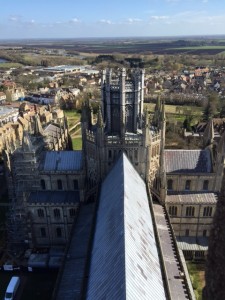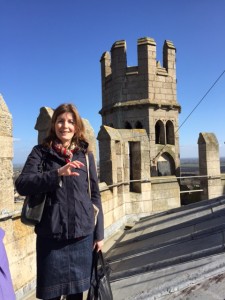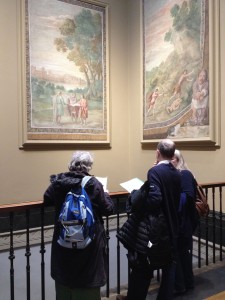It’s my final blog posting before the Easter break, and I do hope everyone has had a good and productive Spring term. Classes may be coming to an end for a few weeks, but events are still ongoing. The ever-active History and Theory of Photography Research Centre, for example, is hosting a fascinating seminar next Tuesday, 24th March, at 6pm: Michael Berkowitz (Professor of Modern Jewish History, UCL) will be giving a paper entitled Not Harry Gresham: Why Helmut Gernsheim’s Jewishness matters.
I want to spend most of this blog telling you about field trips which have been taking place over recent weeks – but, before that, I’m going to raise the issue of student surveys again. Apologies, I know this is the third time! However, I promise it will also be the last occasion on which I’ll say how helpful it would be if you could all complete the surveys which have been sent out by College. These are so valuable for us, as providing vital feedback on what we’re doing well, and what we can do to improve. The National Student Survey is especially important, as one of the ways in which we are scrutinised as a department – so if final year undergraduates, who have been asked to complete the NSS, could take 5 minutes or so out of the last push they’re currently doing on their dissertations, to let us know about their experiences with us, we’d be very grateful. Remember: there are prizes!
Lots of students have been out and about in recent weeks, and members of staff have kindly been taking photos and filling me in on these field trips for the benefit of this blog. I’m most embarrassed to confess that I went to Kenwood House recently with Graduate Certificate and BA students on my ‘Eighteenth-Century Britain: A Polite and Commercial Society’ course, and failed to take a single picture! We had a great time though, looking at works of art by the likes of Angelica Kauffman and Joseph Wright of Derby, as well as getting stiff necks admiring the fantastic ceiling in the Robert Adam Library. I’m just grateful that my colleagues have been more on the ball with their cameras….
* Zoe Opacic and those students taking her Gothic Cathedral course went to visit Ely Cathedral – and you’ll see from this photograph that Zoe’s description of the trip in an email to me as ‘heroic’ does not overstate the case!
– Joanne Anderson and her ‘Italian Mural Painting’ module students went to the National Gallery, to think about the lifespans of Renaissance murals beyond the original time and site of production. Joanne organised her students into groups, and turned them into art detectives for the afternoon: each group was assigned a wall painting, which was a fragment from a larger programme, and a pack of clues comprising catalogue entries, extracts from primary sources and some contextual images. They had an hour of close looking at the artworks, before presenting their findings to the whole group. As Joanne told me, “It was a fun afternoon of thinking about collectors, collection formation, frames and settings and the transfer of wall to canvas. The layers of meaning and new interpretations that make art history exciting!”
* And Leslie Topp sent me this account of a sunny early Spring Saturday morning spent in Pimlico, with students on her MA History of Art option, ‘Space and Politics in Modernity’:
“Pimlico isn’t just pale stucco early Victorian terraces, and good pubs, it also has two very interesting, and in their time very important, post-war council estates. They couldn’t be more different from each other. Churchill Gardens (1947-62, architects Powell & Moya) is a mix of rectilinear slabs and terraces, open and airy, a world unto itself, announcing the optimism and change of the post-war years.
Lillington Gardens (1964-72, Darbourne and Darke) is colourful and textured, variegated and multi-level, emphasising privacy and individuality, and opening out at key points to the surrounding city.
We broke up into small groups to explore, and came back to discuss issues of community, values and politics, as represented by social housing. Then it was off to Tate Britain for the impressive Spotlight display, the New Brutalist Image, which is packed with post-war architecture – don’t think I’ve ever seen architecture so prominently displayed in Tate! And of course tea and a chat in the cafe afterwards.”
Well, it’s time for me to sign off, and to wish you all good Easter breaks. I know there is plenty of work to be done over the vacation, whether that’s coursework such as those BA dissertations, the PhD thesis, reading, revising – or, for staff, getting back to the book manuscript or the latest article. But I do hope that everyone is also able to take the opportunity to have some rest, and can return refreshed and ready for the final term of the academic year.
Kate Retford, Head of Department, History of Art








